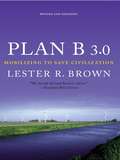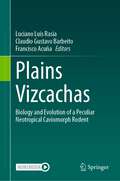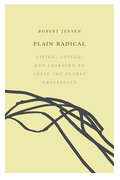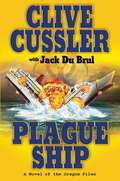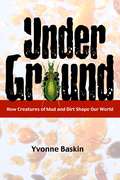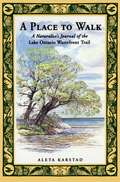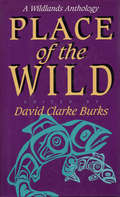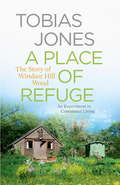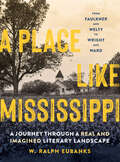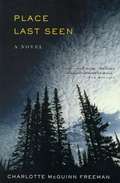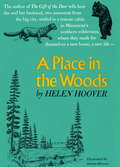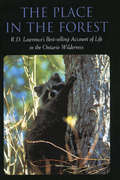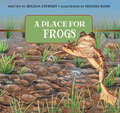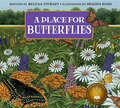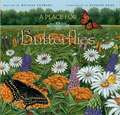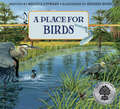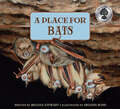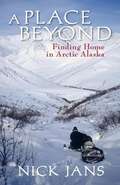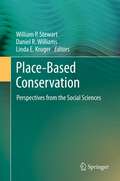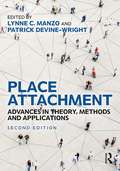- Table View
- List View
Plan B 3. 0: Mobilizing to Save Civilization
by Lester R. BrownThe world faces many environmental trends of disruption. This book has a survival strategy for the early twenty-first-century civilization.
Plains Vizcachas: Biology and Evolution of a Peculiar Neotropical Caviomorph Rodent
by Luciano Luis Rasia Claudio Gustavo Barbeito Francisco AcuñaThe plains vizcacha (Lagostomus maximus) is a remarkable rodent of the Neotropic given several peculiar aspects of its biology, some of them quite unique among rodents or even among mammals. This book gathers specialists studying plains vizcachas from very different approaches, including paleontology, systematics, morphology, physiology, development and conservation. It is divided in two Parts, 1) Evolutionary History, and 2) Morphology, Development and Physiology. It will surely be a required reading for any researcher working with caviomorph rodents, mastozoology of the Neotropics or internal anatomy and physiology of mammals.
Plain Radical: Living, Loving and Learning to Leave the Planet Gracefully
by Robert JensenThere was nothing out of the ordinary about Jim Koplin. He was just your typical central Minnesota gay farm boy with a Ph.D. in experimental psychology who developed anarchist-influenced, radical-feminist, and anti-imperialist politics, while never losing touch with his rural roots. But perhaps the most important thing about Jim is that throughout his life, almost literally to his dying breath, he spent some part of every day on the most important work we have: tending the garden.Plain Radical is a touching homage to a close friend and mentor taken too soon. But it is also an exploration of the ways in which an intensely local focus paired with a fierce intelligence can provide a deep, meaningful, even radical engagement with the world.Drawing on first hand accounts as well as the nearly 3,000 pages of correspondence that flowed between the two men between 1988 and 2012, this book is about the intersection of two biographies and the ideas two men constructed together. It is in part a love story, part intellectual memoir, and part political polemic; an argument for how we should understand problems and think about solutions-in those cases when solutions are possible-to create a decent human future.
Plague Ship: A Novel of the Oregon Files #5
by Clive Cussler Jack DubrulAn exhilarating new adventure in the New York Times-bestselling Oregon Files series. "Readers will burn up the pages following the blazing action and daring exploits of these men and women and their amazing machines" (Publishers Weekly). For four novels, Clive Cussler has charted the exploits of the Oregon, a covert ship completely dilapidated on the outside but on the inside packed with sophisticated weaponry and intelligence-gathering equipment. Captained by the rakish, one-legged Juan Cabrillo and manned by a crew of former military and spy personnel, it is a private enterprise, available for any government agency that can afford it-and now Cussler sends the Oregon on its most extraordinary mission yet. The crew has just completed a top secret mission against Iran in the Persian Gulf when they come across a cruise ship adrift at sea. Hundreds of bodies litter its deck, and, as Cabrillo tries to determine what happened, explosions rack the length of the ship. Barely able to escape with his own life and that of the liner's sole survivor, Cabrillo finds himself plunged into a mystery as intricate-and as perilous-as any he has ever known and pitted against a cult with monstrously lethal plans for the human race... plans he may already be too late to stop. Plague Ship is a high-stakes, high-seas journey that proves once again that Cussler is "just about the best storyteller in the business" (New York Post).
A Plague of Sheep
by Elinor G. K. MelvilleThis is a book about the biological conquest of the New World. Taking as a case study the sixteenth-century history of a region of highland central Mexico, it shows how the environmental and social changes brought about by the introduction of Old World species aided European expansion. The book spells out in detail the environmental changes associated with the introduction of Old World grazing animals into New World ecosystems, demonstrates how these changes enabled the Spanish takeover of land, and explains how environmental changes shaped the colonial societies.
A Plague of Rats and Rubbervines: The Growing Threat Of Species Invasions
by Yvonne BaskinThe human love of novelty and desire to make one place look like another, coupled with massive increases in global trade and transport, are creating a growing economic and ecological threat. The same forces that are rapidly "McDonaldizing" the world's diverse cultures are also driving us toward an era of monotonous, weedy, and uniformly impoverished landscapes. Unique plant and animal communities are slowly succumbing to the world's "rats and rubbervines"--animals like zebra mussels and feral pigs, and plants like kudzu and water hyacinth--that, once moved into new territory, can disrupt human enterprise and well-being as well as native habitats and biodiversity. From songbird-eating snakes in Guam to cheatgrass in the Great Plains, "invasives" are wreaking havoc around the world. In A Plague of Rats and Rubbervines, Yvonne Baskin draws on extensive research to provide an engaging and authoritative overview of this problem. She takes the reader on a worldwide tour of grasslands, gardens, waterways, and forests, describing the troubles caused by exotic organisms that run amok in new settings and examining how commerce and travel on an increasingly connected planet are exacerbating this oldest of human-created problems. She offers potential solutions and profiles individuals worldwide who are working tirelessly to protect the places and creatures they love. While our attention is quick to focus on purposeful attempts to disrupt our lives and economies by releasing harmful biological agents, we often ignore equally serious but much more insidious threats, those that we inadvertently cause by our own seemingly harmless actions. A Plague of Rats and Rubbervines takes a compelling look at this underappreciated problem and sets forth positive suggestions for what we as consumers, gardeners, travelers, nurserymen, fishermen, pet owners, businesspeople--indeed all of us who by our local choices drive global commerce--can do to help."
Placing Nature: Culture And Landscape Ecology
by Joan Nassauer Chris FaustLandscape ecology is a widely influential approach to looking at ecological function at the scale of landscapes, and accepting that human beings powerfully affect landscape pattern and function. It goes beyond investigation of pristine environments to consider ecological questions that are raised by patterns of farming, forestry, towns, and cities.Placing Nature is a groundbreaking volume in the field of landscape ecology, the result of collaborative work among experts in ecology, philosophy, art, literature, geography, landscape architecture, and history. Contributors asked each other: What is our appropriate role in nature? How are assumptions of Western culture and ingrained traditions placed in a new context of ecological knowledge? In this book, they consider the goals and strategies needed to bring human-dominated landscapes into intentional relationships with nature, articulating widely varied approaches to the task.In the essays: novelist Jane Smiley, ecologist Eville Gorham, and historian Curt Meine each examine the urgent realities of fitting together ecological function and culture philosopher Marcia Eaton and landscape architect Joan Nassauer each suggest ways to use the culture of nature to bring ecological health into settled landscapes urban geographer Judith Martin and urban historian Sam Bass Warner, geographer and landscape architect Deborah Karasov, and ecologist William Romme each explore the dynamics of land development decisions for their landscape ecological effects artist Chris Faust's photographs juxtapose the crass and mundane details of land use with the poetic power of ecological pattern.Every possible future landscape is the embodiment of some human choice. Placing Nature provides important insight for those who make such choices -- ecologists, ecosystem managers, watershed managers, conservation biologists, land developers, designers, planners -- and for all who wish to promote the ecological health of their communities.
Places in My Community (Into Reading, Read Aloud #Module 3, Book 1)
by Bobbie KalmanNIMAC-sourced textbook
A Place to Walk: A Naturalist's Journal of the Lake Ontario Waterfront Trail
by Aleta KarstadWhat do experienced field naturalists discover when they explore the heavily populated Lake Ontario shoreline as if they were surveying a wilderness for the first time? In this beautifully illustrated book, Aleta Karstad takes you on a journey of discovery along the route of the Lake Ontario Waterfront Trail. Listening for calling frogs in spring, turning stones, sampling shoreline drift, identifying plants and animals, Karstad and her husband, herpetologist Frederick W. Schueler, discover a wealth of natural life, sometimes in unexpected places. The expedition journal, illustrated by Aleta Karstad’s elegant drawings and delicate watercolours, takes up where popular field guides leave off. It is a guide and inspiration for readers to explore their own region with fresh eyes, with an invitation to assist in monitoring animal communities.
Place of the Wild: A Wildlands Anthology
by John Davis David Abram Kirkpatrick Sale Max Oelschlaeger David Clarke Burks Margaret Hayes YoungWhere and what is the place of the wild? Is the goal of preserving biodiversity across the landscape of North America compatible with contemporary Western culture?Place of the Wild brings together original essays from an exceptional array of contemporary writers and activists to present in a single volume the most current thinking on the relationship between humans and wilderness. A common thread running through the volume is the conviction that everyone concerned with the natural world -- academics and activists, philosophers and poets -- must join forces to re-establish cultural narratives and shared visions that sustain life on this planet.The contributors apply the insights of conservation biology to the importance of wilderness in the 21st century, raising questions and stimulating thought. The volume begins with a series of personal narratives that present portraits of wildlands and humans. Following those narratives are more-analytical discourses that examine conceptions and perceptions of the wild, and of the place of humanity in it. The concluding section features clear and resonant activist voices that consider the importance of wildlands, and what can be done to reconcile the needs of wilderness with the needs of human culture.
A Place of Refuge: An Experiment in Communal Living – The Story of Windsor Hill Wood
by Tobias JonesFive years ago, Tobias Jones and his wife set up a woodland sanctuary for people in a period of crisis in their lives. Windsor Hill Wood quickly becomes a well-known refuge, and a family home is transformed into a small community. Most people arrive because of a desperate need - bereavement, depression, addiction or homelessness - while others come simply because they are dismayed by modern life. A Place of Refuge is the story of an evolving community: the characters and conflicts, the miracles and mistakes. As the seasons turn in the bustling woodland, an ever-changing group of people try to share their money, their meals and ideals; making furniture, growing vegetables and rearing livestock. Encountering both violent antagonism and astounding generosity, the family open up not only their house, but also themselves, to the most demanding of judgements and transformations. This book is not about a retreat from the world, but about a deeper engagement with it. Living alongside troubled guests, Jones examines the consequences of our way of life - seeing up close the scars of war, abuse and loneliness - and contemplates the ways in which nature and stillness offer solace to those in torment.
A Place of Refuge: An Experiment in Communal Living – The Story of Windsor Hill Wood
by Tobias JonesFive years ago, Tobias Jones and his wife set up a woodland sanctuary for people in a period of crisis in their lives. Windsor Hill Wood quickly becomes a well-known refuge, and a family home is transformed into a small community. Most people arrive because of a desperate need - bereavement, depression, addiction or homelessness - while others come simply because they are dismayed by modern life.A Place of Refuge is the story of an evolving community: the characters and conflicts, the miracles and mistakes. As the seasons turn in the bustling woodland, an ever-changing group of people try to share their money, their meals and ideals; making furniture, growing vegetables and rearing livestock. Encountering both violent antagonism and astounding generosity, the family open up not only their house, but also themselves, to the most demanding of judgements and transformations. This book is not about a retreat from the world, but about a deeper engagement with it. Living alongside troubled guests, Jones examines the consequences of our way of life - seeing up close the scars of war, abuse and loneliness - and contemplates the ways in which nature and stillness offer solace to those in torment.
The Place of Many Moods: Udaipur’s Painted Lands and India’s Eighteenth Century
by Dipti KheraA look at the painting traditions of northwestern India in the eighteenth century, and what they reveal about the political and artistic changes of the eraIn the long eighteenth century, artists from Udaipur, a city of lakes in northwestern India, specialized in depicting the vivid sensory ambience of its historic palaces, reservoirs, temples, bazaars, and durbars. As Mughal imperial authority weakened by the late 1600s and the British colonial economy became paramount by the 1830s, new patrons and mobile professionals reshaped urban cultures and artistic genres across early modern India. The Place of Many Moods explores how Udaipur’s artworks—monumental court paintings, royal portraits, Jain letter scrolls, devotional manuscripts, cartographic artifacts, and architectural drawings—represent the period’s major aesthetic, intellectual, and political shifts. Dipti Khera shows that these immersive objects powerfully convey the bhava—the feel, emotion, and mood—of specific places, revealing visions of pleasure, plenitude, and praise. These memorialized moods confront the ways colonial histories have recounted Oriental decadence, shaping how a culture and time are perceived.Illuminating the close relationship between painting and poetry, and the ties among art, architecture, literature, politics, ecology, trade, and religion, Khera examines how Udaipur’s painters aesthetically enticed audiences of courtly connoisseurs, itinerant monks, and mercantile collectives to forge bonds of belonging to real locales in the present and to long for idealized futures. Their pioneering pictures sought to stir such emotions as love, awe, abundance, and wonder, emphasizing the senses, spaces, and sociability essential to the efficacy of objects and expressions of territoriality.The Place of Many Moods uncovers an influential creative legacy of evocative beauty that raises broader questions about how emotions and artifacts operate in constituting history and subjectivity, politics and place.
A Place Like Mississippi: A Journey Through a Real and Imagined Literary Landscape
by W. Ralph Eubanks&“This is the book all of us Mississippi writers, dead and alive, need to read. It is indeed a strange but glorious sensation to see your literary and geographic lineage so beautifully and rigorously explored and valued as it's still being created.&” —Kiese Laymon, author of Heavy: An American MemoirIn A Place Like Mississippi, award-winning author and Mississippi native W. Ralph Eubanks treats us to a literary tour of the evocative landscapes that have inspired writers in every era. From Faulkner to Wright, Welty to Trethewey, Mississippi has been both a backdrop and a central character in some of the most compelling prose and poetry of modern literature.The journey unfolds on a winding path, touching the muddy Delta, the rolling Hill Country, down to the Gulf Coast, and all points between. In every corner of the state lie the settings that informed hundreds of iconic works.Immersing us in these spaces, Eubanks helps us understand that Mississippi is not only a state but a state of mind. Or as Faulkner is said to have observed, &“To understand the world, you must first understand a place like Mississippi.&”
Place Last Seen
by Charlotte Mcguinn FreemanDURING AN IDYLLIC AUTUMN-DAY hike in the Desolation Wilderness of the Sierra Nevadas, the Baker family is hurled into a nightmare. Playing hide-and-seek with her older brother, Luke, six-year-old Maggie runs away-and she cannot be found. Her father, Richard, and mother, Anne, search desperately before racing down the mountain to call in a Search and Rescue team. The team arrives with experienced trackers, volunteers, dogs, and topographic maps and begins a thorough search from the place where Maggie was last seen. But the search is complicated by an unpredictable factor: willful and energetic, Maggie Baker is also a Down Syndrome child, and there is no telling how she will move as she wanders in the wilderness. Richard, Anne, and Luke can only wait and hope that she will leave a clue, a trail that will lead them to her. With great empathy, Charlotte McGuinn Freeman conveys the gripping reality of the search and how this tests the bonds of a family as it grapples with guilt, doubt, fear, and frantic hope. Powerful, suspenseful, and deeply affecting, Place Last Seen marks the debut of a gifted new voice.
A Place in the Woods
by Helen HooverHelen Hoover and her husband, Adrian, were trailblazers in the American back-to-the-land movement. Well ensconced in their professional lives in Chicago, they made the decision to follow their dream of a simple existence, pulling up their stakes and plunging into the wilds of northern Minnesota. A Place in the Woods, first published in 1969, describes how the Hoovers gradually adapted to the rigors of wilderness survival. This book relates events that occurred prior to those Hoover writes about in her bestselling Gift of the Deer. This is a tale of starting out, of the pitfalls of beginning a new life-one punctuated by near disasters but also by moments of rare beauty.
The Place in the Forest
by R. D. LawrenceA number of years ago, R.D. Lawrence acquired a patch of Ontario wilderness, soon known as "The Place." Here Lawrence and his wife built a cabin and became immersed in studying the ways of the wild. "The Place" was home to a variety of wildlife, from black bears, wolves, beavers and raccoons through to hawks, snapping turtles and singing mice. Lawrence’s desire to learn, fuelled by his keen observation, led to his writing about and photographing life within his small corner of the forest – the result being a warm, witty account of change and survival in the natural world.
A Place for Frogs (A Place For. . . #3)
by Melissa StewartThe population of frogs in the United States has been declining for the past fifty years, even in our protected national parks. What dangers do frogs face? How can we help?In simple yet engaging language, acclaimed science writer Melissa Stewart showcases twelve types of North American frogs, from the wood frog to the now rare Oregon spotted frog. Her clear narrative shows the threats these frogs face, and informative sidebars describe a wide variety of efforts to save them. In addition, remarkable full-color illustrations vividly and accurately depict the frogs within the ecosystems that support their survival. This nonfiction picture book is part of a prize-winning series designed to inform young readers about a wide range of environmental issues and to present ways people can help protect animals and their natural habitats.
A Place for Butterflies (A Place For. . . #1)
by Melissa StewartOnce abundant monarch butterflies are disappearing in the United States, but that's only part of the story. Many other butterfly species are also in trouble, and human action is often the cause of their plight. What can we do to help protect this important insect?In clear and compelling language, Melissa Stewart showcases twelve North American butterflies—from the familiar eastern tiger swallowtail to the rare Palos Verdes blue butterfly—and the ecosystems that support their survival. The simple narrative states the dangers that each of these butterfly populations face, and informative sidebars describe the efforts of people to save them. Featuring glorious full-color illustrations by Higgins Bond and range maps for each butterfly, this book is perfect for aspiring entomologists and conservationists. This nonfiction picture book is one of the six titles in the prize-winning A Place for... series, a collection that opens readers' minds to a wide range of environmental issues and shows how humans are striving to protect animals and their natural habitats.
A Place For Butterflies
by Melissa Stewart Higgins BondDirections for creating backyard gardens and planting specific trees that attract butterflies are also included. Author Melissa Stewart offers children a glimpse into the interconnectedness of our world and how the actions of one species can inadvertently harm another
A Place for Birds (A Place For. . . #2)
by Melissa StewartNorth America has almost three billion fewer birds now than it had fifty years ago. It may be hard to believe, but birds are in danger, and they are calling for our help. Sadly, humans are often the source of the harm! What can we do to help save them?In simple yet compelling language, Melissa Stewart showcases twelve North American birds, from the familiar eastern bluebird to the rare Kirtland's warbler. Her clear narrative shows the threats these birds face, and informative sidebars describe a wide variety of efforts to save them. In addition, remarkable full-color illustrations vividly and accurately depict the birds within the ecosystems that support their survival. Range maps and additional bird facts are also included.This nonfiction picture book is part of the prize-winning A Place for... series designed to inform young readers about a wide range of environmental issues and to present ways people can help protect animals and their natural habitats. An ideal choice for young birders, scientists, environmentalists, and nature lovers.
A Place for Bats (A Place For. . . #5)
by Melissa StewartDid you know that almost a third of the world's 1,300 species of bats are in serious trouble?Chased from their caves and forests, sickened by cave-dwelling fungi, and swept from the skies by wind turbines, bats have no place to hide. And human actions often contribute to the problems. How can we help ensure that there will be a safe place for bats?In simple yet compelling language, acclaimed science writer Melissa Stewart showcases twelve types of North American bats, from the familiar little brown bat to the Mexican free-tailed bat. Her clear narrative shows the threats these bats face, and informative sidebars describe a variety of efforts to save them.In addition, remarkable full-color illustrations vividly and accurately depict bats within the ecosystems that support their survival. Range maps and additional bat facts are also included.This nonfiction picture book is part of a prize-winning series designed to inform young readers about a wide range of environmental issues and to present ways people can help protect animals and their natural habitats. A classroom favorite, this book is perfect for budding scientists, environmentalists, and nature lovers.
A Place Beyond: Finding Home in Arctic Alaska
by Nick JansNick Jans leads us into his "found" home--the Eskimo village of Ambler, Alaska, and the vast wilderness around it. In his powerful essays, the rhythms of daily arctic life blend with high adventure--camping among the wolves, traveling with Inupiat hunters, witnessing the Kobuk River at spring breakup. The poignancy of a village funeral comes to life, hordes of mosquitoes whine against a tent, a grizzly stands etched against the snow--just a sampling of the images and events rendered in Jans' transparent, visual prose. Moments of humor are offset by haunting insights, and by thoughtful reflections on contemporary Inupiaq culture, making A Place Beyond a book to read and enjoy.
Place-Based Conservation
by Linda E. Kruger Suzette Dailey William P. StewartThe concept of "Place" has become prominent in natural resource management, as professionals increasingly recognize the importance of scale, place-specific meanings, local knowledge, and social-ecological dynamics. Place-Based Conservation: Perspectives from the Social Sciences offers a thorough examination of the topic, dividing its exploration into four broad areas. Place-Based Conservation provides a comprehensive resource for researchers and practitioners to help build the conceptual grounding necessary to understand and to effectively practice place-based conservation.
Place Attachment: Advances in Theory, Methods and Applications
by Lynne C. Manzo Patrick Devine-WrightFollowing on from the ground-breaking first edition, which received the 2014 EDRA Achievement Award, this fully updated text includes new chapters on current issues in the built environment, such as GIS and mapping, climate change, and qualitative approaches. Place attachments are powerful emotional bonds that form between people and their physical surroundings. They inform our sense of identity, create meaning in our lives, facilitate community, and influence action. Place attachments have bearing on such diverse issues as rootedness and belonging, placemaking and displacement, mobility and migration, intergroup conflict, civic engagement, social housing and urban redevelopment, natural resource management, and global climate change. In this multidisciplinary book, Manzo and Devine-Wright draw together the latest thinking by leading scholars from around the globe, including contributions from scholars such as Daniel Williams, Mindy Fullilove, Randy Hester, and David Seamon, to capture significant advancements in three main areas: theory, methods, and applications. Over the course of fifteen chapters, using a wide range of conceptual and applied methods, the authors critically review and challenge contemporary knowledge, identify significant advances, and point to areas for future research. This important volume offers the most current understandings about place attachment, a critical concept for the environmental social sciences and placemaking professions.
